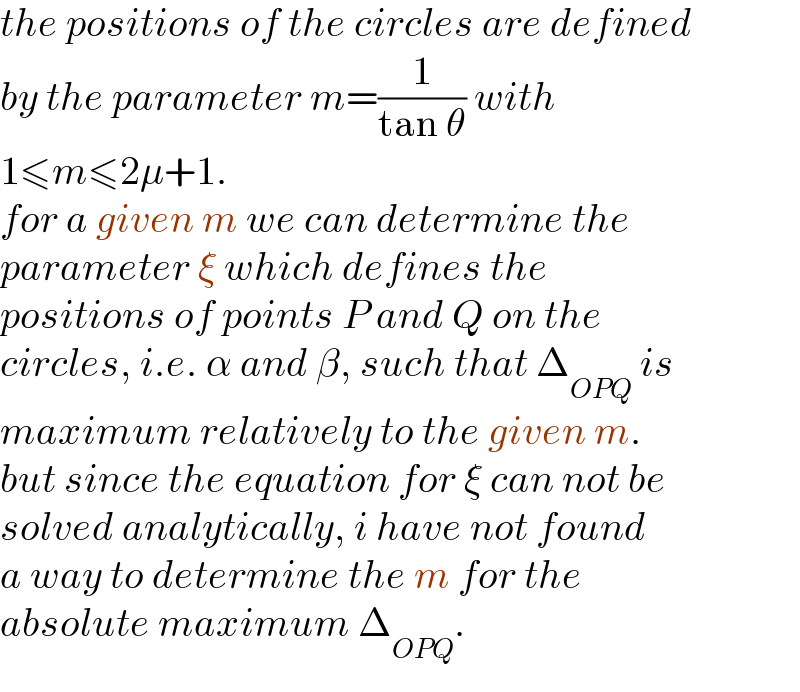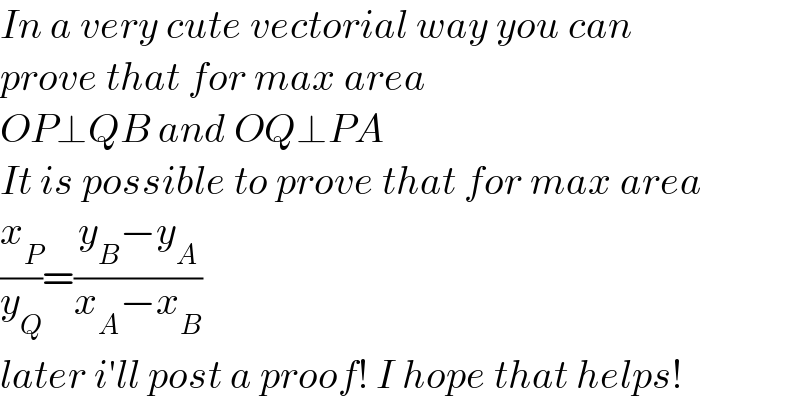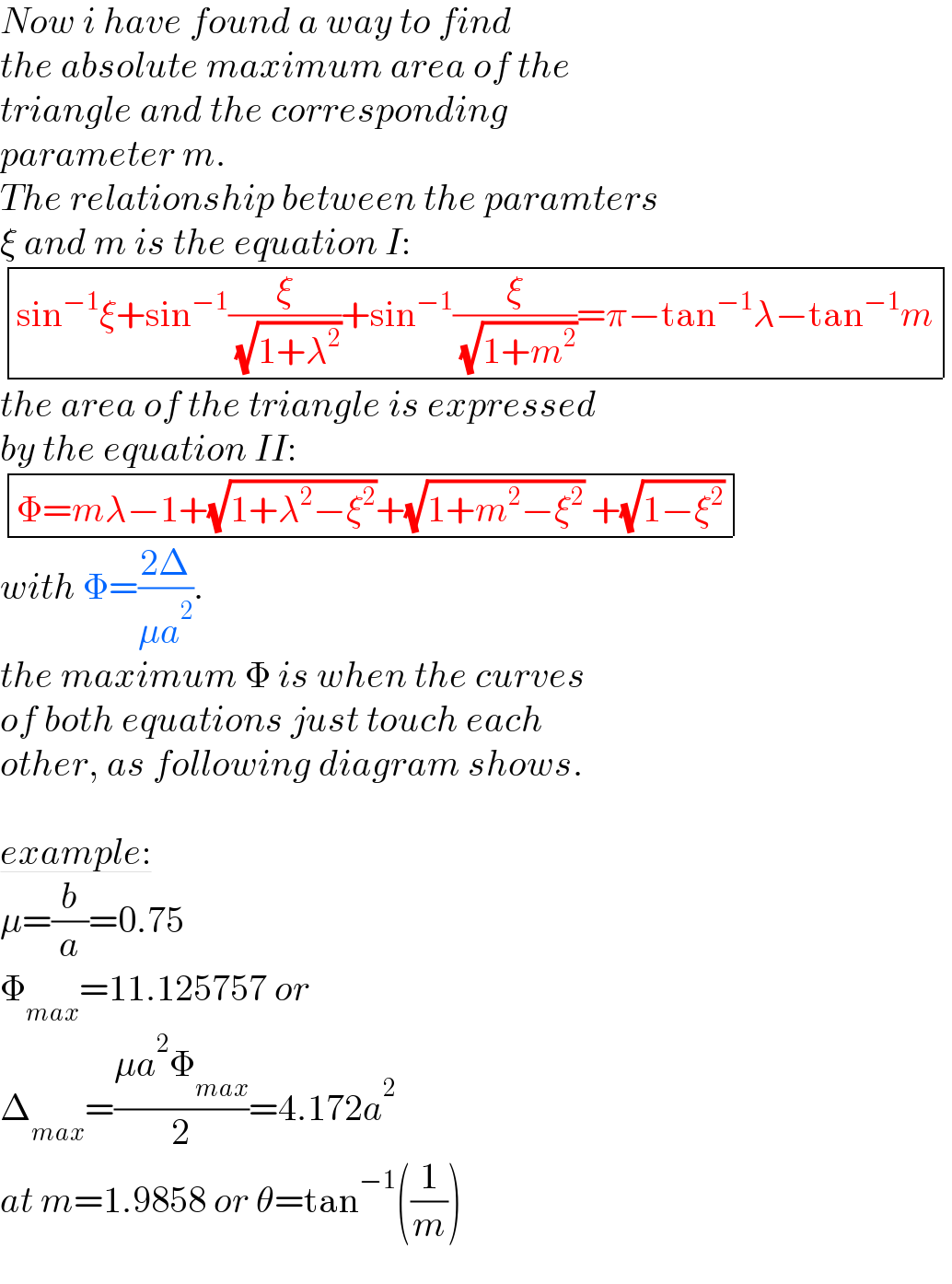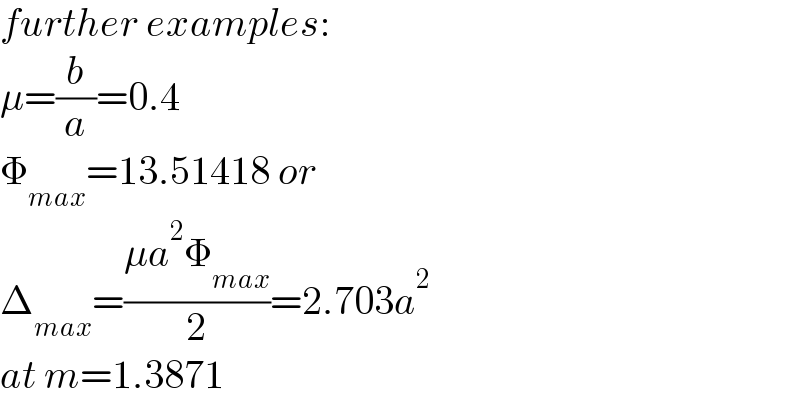
Question and Answers Forum
Question Number 165600 by mr W last updated on 05/Feb/22

Commented by mr W last updated on 05/Feb/22

Commented by mr W last updated on 05/Feb/22

Commented by mr W last updated on 06/Feb/22
![let μ=(b/a)≤1 A((a/(tan θ)), a)=(ma, a) B(b, y_B ) (y_B −a)^2 +((a/(tan θ))−b)^2 =(a+b)^2 (y_B −a)^2 =a^2 (1+(1/(tan θ)))(2μ+1−(1/(tan θ))) let m=(1/(tan θ)) y_B =a+a(√((1+m)(2μ+1−m))) tan θ≥(a/(a+2b))=(1/(2μ+1)) θ≤(π/4) ⇒1≤m≤2μ+1 x_P =(a/(tan θ))+a sin α=a(m+sin α) y_P =a−a cos α=a(1−cos α) x_Q =b−b cos β=aμ(1−cos β) y_Q =y_B +b sin β=a[1+(√((1+m)(2μ+1−m)))+μ sin β] area of triangle OPQ: Δ=((x_Q y_Q )/2)+(((x_P −x_Q )(y_P +y_Q ))/2)−((x_P y_P )/2) 2Δ=x_P y_Q −x_Q y_P 2Δ=a^2 (m+sin α)(1+(√((1+m)(2μ+1−m)))+μ sin β)−a^2 μ(1−cos β)(1−cos α) ((2Δ)/(μa^2 ))=(m+sin α)(((1+(√((1+m)(2μ+1−m))))/μ)+sin β)−(1−cos β)(1−cos α) let Φ=((2Δ)/(μa^2 )), λ=((1+(√((1+m)(2μ+1−m))))/μ) Φ=(m+sin α)(λ+sin β)−(1−cos β)(1−cos α) Φ=mλ−1+λ sin α+cos α+m sin β+cos β−cos (α+β) Φ=mλ−1+(√(1+λ^2 )) cos (α−tan^(−1) λ)+(√(1+m^2 )) cos (β−tan^(−1) m)−cos (α+β) Φ is a function of three variables: m, α, β. i′ll try in geometric way: for maiximum area of triangle OPQ, tangent at Q must be // OP: (1/(tan β))=(y_P /x_P )=((1−cos α)/(m+sin α)) ⇒((cos β)/(sin β))=((1−cos α)/(m+sin α)) m cos β−sin β+sin α cos β+cos α sin β=0 m cos β−sin β+sin (α+β)=0 ⇒(√(1+m^2 )) sin (β−tan^(−1) m)=sin (α+β) (we can get the same also from (∂Φ/∂β)=0) tangent at P must be // OQ: tan α=(y_Q /x_Q )=((1+(√((1+m)(2μ+1−m)))+μ sin β)/(μ(1−cos β))) ⇒((sin α)/(cos α))=((λ+sin β)/(1−cos β)) λ cos α−sin α+cos α sin β+sin α cos β=0 λ cos α−sin α+sin (α+β)=0 ⇒(√(1+λ^2 )) sin (α−tan^(−1) λ)=sin (α+β) (we can get the same also from (∂Φ/∂α)=0) we can see that (π/2)<α+β<π in case of that Δ is maximum. say (√(1+λ^2 )) sin (α−tan^(−1) λ)=(√(1+m^2 )) sin (β−tan^(−1) m)=sin (α+β)=ξ ⇒α=tan^(−1) λ+sin^(−1) (ξ/( (√(1+λ^2 )))) ⇒β=tan^(−1) m+sin^(−1) (ξ/( (√(1+m^2 )))) ⇒α+β=π−sin^(−1) ξ determinant (((sin^(−1) ξ+sin^(−1) (ξ/( (√(1+λ^2 ))))+sin^(−1) (ξ/( (√(1+m^2 ))))=π−tan^(−1) λ−tan^(−1) m))) ...(I) (√(1+λ^2 )) sin (α−tan^(−1) λ)=ξ ⇒cos (α−tan^(−1) λ)=(√(1−(ξ^2 /(1+λ^2 )))) (√(1+m^2 )) sin (β−tan^(−1) m)=ξ ⇒cos (β−tan^(−1) m)=(√(1−(ξ^2 /(1+m^2 )))) sin (α+β)=ξ ⇒cos (α+β)=−(√(1−ξ^2 )) Φ=mλ−1+(√(1+λ^2 )) cos (α−tan^(−1) λ)+(√(1+m^2 )) cos (β−tan^(−1) m)−cos (α+β) determinant (((Φ=mλ−1+(√(1+λ^2 −ξ^2 ))+(√(1+m^2 −ξ^2 )) +(√(1−ξ^2 ))))) ...(II)](Q165603.png)
Commented by mr W last updated on 05/Feb/22

Commented by mr W last updated on 05/Feb/22

Commented by mr W last updated on 05/Feb/22

Commented by mr W last updated on 05/Feb/22

Commented by aleks041103 last updated on 05/Feb/22

Commented by mr W last updated on 05/Feb/22

Commented by Tawa11 last updated on 05/Feb/22

Commented by mr W last updated on 06/Feb/22

Commented by mr W last updated on 06/Feb/22

Commented by mr W last updated on 06/Feb/22

Commented by mr W last updated on 06/Feb/22

Commented by mr W last updated on 06/Feb/22

Commented by mr W last updated on 06/Feb/22

Commented by mr W last updated on 06/Feb/22

Commented by mr W last updated on 06/Feb/22

Commented by mr W last updated on 06/Feb/22

